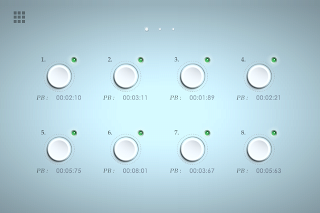It was originally only for iPad, but a recent update added iPhone compatibility.
The basic idea isn't new: a ball moves on the screen, following the laws of physics. Without support, the ball would fall through the bottom of the screen, so the player must set up a path which the ball can roll on. The goal is to make the ball touch a few waypoints scattered across the screen.
I had seen similar games where you had to draw the path with your finger; in this case, however, the path is created by adjusting the control points of a Bézier curve, hence the title of the game. The Bézier curve ensures that that the lines are always smoothly curved.
The presentation is very clean and polished; the font and the drawing style look like those you could find in a physics textbook. The buttons have LEDs on their sides as if they were control switches of some laboratory apparatus.
For precise control, you can also zoom in using the pinch gesture.
The Bézier curve is not the only thing you can control: in many puzzles you'll be given other props, which play a fundamental part in the solution.
The first prop you meet is the Velocity Boost, which accelerates the ball in the direction of your choice.
Then there are bumpers, like the ones found in pinball machines.
Often times, the props you are given have a padlock next to them, meaning that they can't be moved. In some cases, even some of the curve's control points can be locked, which gives an interesting twist to the puzzles.
There's a total of 80 puzzles, split across 4 groups of 20 puzzles each.
The second group introduces portals, which open up a lot of possibilities. Don't try the infinite fall trick which you could do in the Portal video game by Valve, though: sadly, the portals disappear after you pass through them.
The puzzles containing portals tend to also contain impenetrable walls, so you need to use the portal as the only mean to get on the other side.
The third group of puzzles introduces yet another game-changing feature: switches that invert the direction of gravity when touched by the ball.
The puzzles are well designed and often require some lateral thinking to find a solution. The different props, the possibility of them to be locked in place, and the presence of walls, ensure that there is a lot of variety and different challenges to overcome.
If you get stuck, you can use the light bulb button to get a hint. Hints are very well done and, instead of giving a detailed solution, draw a sketch of the basic elements needed. They seem to be more explicit in the first few puzzles and more suggestive in the later ones.
The game also keeps track of the best time it took to solve each puzzle. That's not the time it took you to find a solution, but the time it took the ball to go through all waypoints after pressing the start button. If you are so inclined, you can try to improve your times, though at the time of writing there is no support for Game Center leaderboards.
The puzzle selection screen (on iPhone at least) isn't great: it is paged and you can see 8 puzzles at a time, but each group contains 20 puzzles, so you get only 4 puzzles in the third page. This feels odd, surely two pages with 10 puzzles each would seem to make more sense.
The other nitpick I have is that there are long fades between the screens, which make it tedious to go back from the game screen to the level selection screen.
If you like physics puzzles, Bézier is a worthy addition, with good mechanics and an impeccable presentation. A free version is also available to try it before buying the full version.
Summary
| Nontrivialness | ★★★☆☆ |
| Logical Reasoning | ★★★★☆ |
| User Interface | ★★★☆☆ |
| Presentation | ★★★★★ |
| Loading Time | ★★★☆☆ |
| Saves Partial Progress | ✘ |
| Status Bar | ✘ |
©2013 Nicola Salmoria. Unauthorized use and/or duplication without express and written permission is strictly prohibited. Excerpts and links may be used, provided that full and clear credit is given to Nicola Salmoria and nontrivialgames.blogspot.com with appropriate and specific direction to the original content.








